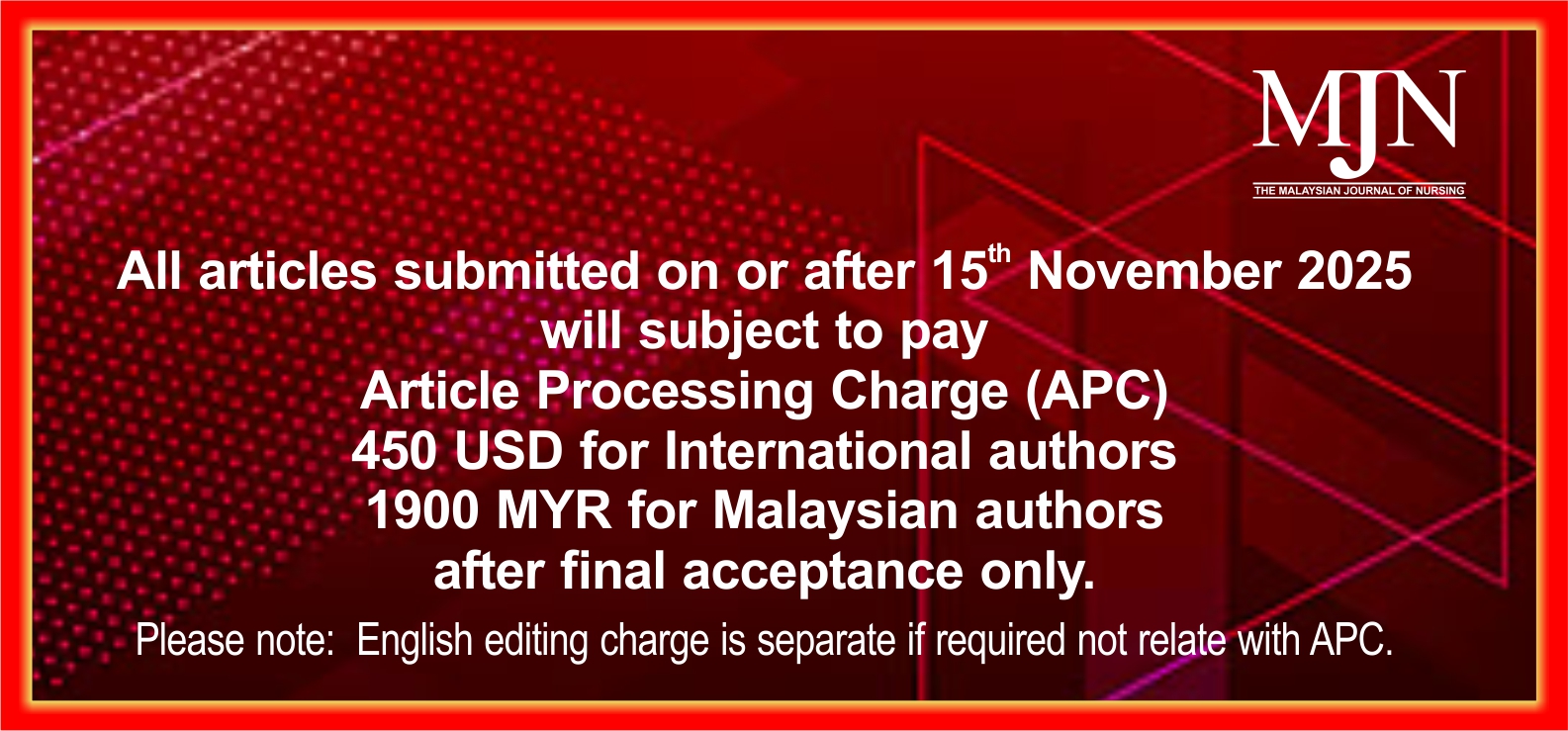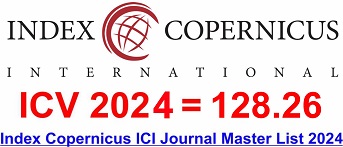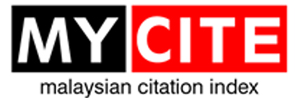Prevalence of Obesity and Health-Promoting Lifestyle Profile among Malaysian and Indonesian Nurses
DOI:
https://doi.org/10.31674/mjn.2025.v16i04.011Abstract
Background: Harmful lifestyle behaviours trigger physiological changes that multiply the risk of non-communicable diseases in the population. Methods: A descriptive cross-sectional survey was used to compare the prevalence of obesity and Health-Promoting Lifestyle Profiles (HPLP) among Malaysian and Indonesian Nurses. A total of 417 and 406 nurses from Malaysia and Indonesia participated in the study, respectively. Purposive sampling was used to select facilities, while convenience sampling was used for respondents’ selection. Data was collected using an online Google form and analysis was done using SPSS version 25.0. Results: The result of the study shows a significant association between age (p = 0.001 vs. 0.001) and marital status (p = 0.001 vs. 0.03) with BMI for Malaysia and Indonesia, respectively. A high prevalence rate of obesity was observed in Malaysia (55.9%) and Indonesia (47%). The total HPLP II score of the respondents were Malaysia (142.46 ± 22.70) and Indonesia (129.77 ± 17.89). Spiritual growth and interpersonal relationships had the highest subscale scores for both countries. Physical activity was lowest at 19.45 ± 4.54 vs 18.04 ± 4.27 for Malaysia and Indonesia, respectively. Lastly, a statistically weak relationship was found when BMI was correlated with health responsibility (r = 0.129, p = 0.009) for Malaysia. Similarly, weak correlations were observed in Indonesia between BMI and physical activity (r = 0.106, p = 0.033) and between BMI and interpersonal relationships (r = 0.120, p = 0.015). Conclusion: The prevalence of obesity was high, while physical activity was lowest for both countries.
Keywords:
Health, Indonesia, Lifestyle(s), Malaysia, Nurse(s), ObesityDownloads
References
Allari, R. S., & Manal, A. L. (2022). The level of physical activity among nursing students: A descriptive study. Journal of Pharmaceutical Negative Results, 13(2), 9287-9302. Retrived from: https://www.pnrjournal.com/index.php/home/article/view/6552
Arifin, H., Chou, K. R., Ibrahim, K., Fitri, S. U. R. A., Pradipta, R. O., Rias, Y. A., ... & Pahria, T. (2022). Analysis of modifiable, non-modifiable, and physiological risk factors of non-communicable diseases in Indonesia: evidence from the 2018 Indonesian basic health research. Journal of Multidisciplinary Healthcare, 2203-2221. https://doi.org/10.2147/JMDH.S382191
Budury, S., Sharoni, S. K. A., Gusmantara, P., Purwanti, N., & Hidaayah, N. (2024). Health promoting lifestyle among nurses in Indonesia. Revista de Gestão Social e Ambiental, 18(5), 1-9. https://doi.org/10.24857/rgsa.v18n5-069
Cao, X., Yang, G., Li, X., Fu, J., Mohedaner, M., Danzengzhuoga, Høj Jørgensen, T. S., Agogo, G. O., Wang, L., Zhang, X., Zhang, T., Han, L., Gao, X., & Liu, Z. (2023). Weight change across adulthood and accelerated biological aging in middle-aged and older adults. The American Journal of Clinical Nutrition, 117(1), 1–11. https://doi.org/10.1016/j.ajcnut.2022.10.020
CDC Global Health (2021) About the division of global health protection. Retrieved from: https://www.cdc.gov/global-health/organization/about-division-of-global-health-protection.html. Accessed on 5th July, 2024.
Chong, C. T., Lai, W. K., Mohd Sallehuddin, S., & Ganapathy, S. S. (2023). Prevalence of overweight and its associated factors among Malaysian adults: Findings from a nationally representative survey. PLoS One, 18(8). https://doi.org/10.1371/journal.pone.0283270
Dadar Singh, N. K., Loo, J. L., Ko, A. M. N., Husain, S. S., Dony, J. F., & Syed Abdul Rahim, S. S. (2022). Obesity and mental health issues among healthcare workers: a cross-sectional study in Sabah, Malaysia. Journal of Health Research, 36(5), 939-945. https://doi.org/10.1108/JHR-07-2020-0269
Diani, Y. H., Novelyn, S., Cing, J. M., Suryowati, T., Aritonang, C. R., Daroedono, E., & Andiani, A. T. (2023). Prevalence of overweight and obesity among medical students across Indonesia: A literature review. Asian Journal of Biology, 18(2), 34-45. https://doi.org/10.9734/ajob/2023/v18i2341
Ganesrau, G., Ali, A., Mohamed, H. J. J., Zainuddin, A. A., Yusof, H. M., & Jean, S. W. (2023). Ultra-processed food consumption about Body Mass Index (BMI) of public university students in Malaysia. Malaysian Applied Biology, 52(2), 119–127. https://doi.org/10.55230/mabjournal.v52i2.2663
Hanafi, E., Siste, K., Limawan, A. P., Sen, L. T., Christian, H., Murtani, B. J., ... & Suwartono, C. (2021). Alcohol-and cigarette-use related behaviors during quarantine and physical distancing amid COVID-19 in Indonesia. Frontiers in Psychiatry, 12. https://doi.org/10.3389/fpsyt.2021.622917
Hoveidamanesh, S., Tayefi, B., Rampisheh, Z., Khalili, N., & Ramezani, M. (2022). Factors affecting the physical activity of healthcare workers of Iran University of Medical Sciences: A qualitative study. Archives of Public Health, 80(1). https://doi.org/10.1186/s13690-022-00963-7
Ifroh, R. H., Imamah, I. N., & Rizal, A. A. F. (2022). The health-promoting lifestyle assessment among nursing students in East Kalimantan. Jurnal Ilmu Kesehatan Masyarakat, 13(2), 168-179. https://doi.org/10.26553/jikm.2022.13.2.168-179
Kapaj, A., Gaxhja, E., Bani, B. & Gugu, M. (2025). Health-promoting lifestyle and its predictors among students of the university of elbasan, albania: A cross-sectional study. Open Public Health Journal, 18. http://dx.doi.org/10.2174/0118749445373968250203092516
Kuan, G., Kueh, Y. C., Abdullah, N., & Tai, E. L. M. (2019). Psychometric properties of the health-promoting lifestyle profile II: Cross-cultural validation of the Malay language version. BMC Public Health, 19, 1-10. https://doi.org/10.1186/s12889-019-7109-2
Luh, D. L., Huang, H. L., Chiou, S. Y., Lo, K. Y., & Chen, F. L. (2025). The association between organizational factors of health promoting schools and teachers' health lifestyles: A multilevel analysis. The Journal of School Health, 95(2), 126–133. https://doi.org/10.1111/josh.13523
McCrum-Gardner, E. (2010). Sample size and power calculations made simple. International Journal of Therapy and Rehabilitation, 17(1), 10-14. https://doi.org/10.12968/ijtr.2010.17.1.45988
Rafat, N., Bakouei, F., Adib-Rad, H., Nikbakht, H. A., & Bakouei, S. (2025). Predicting the health-promoting lifestyle profile of pregnant women based on their health literacy levels: A cross-sectional study. Nursing Open, 12(1). https://doi.org/10.1002/nop2.70136
Sato, K. (2021). Relationship between marital status and body mass index in Japan. Review of Economics of the Household, 19(3), 813-841. https://doi.org/10.1007/s11150-020-09503-0
Shamsuddin, S. M. S., Ahmad, N., Sutan, R., & Ibrahim, R. (2025). The role of self-efficacy towards health-promoting lifestyle among patients with non-communicable disease: A systematic literature review. medRxiv, 01-19. https://doi.org/10.1101/2025.01.05.25320027
Sharoni, S. K. A., Hassan, N. H. N., Halim, N. A., & Budury, S. (2023). Prevalence of obesity and health-promoting lifestyle among nurses in a Tertiary Hospital, Malaysia. Environment-Behaviour Proceedings Journal, 8(24), 355-360. https://doi.org/10.21834/ebpj.v8i24.4679
Sklempe Kokic, I., Barusic, Z., Crnkovic Knezevic, M., Benko Mestrovic, S., & Duvnjak, I. (2022). Physical activity and health-promoting behaviours of nurses and physiotherapists: A cross-sectional survey. Health Education and Health Promotion, 10(3), 433-441. Retrieved from: http://hehp.modares.ac.ir/article-5-62111-en.html. Accessed on 10th July, 2023.
Tapare, Vinay Shridhar Borle, P. S., Parande, Malangori Abdulgani, Sakore, Deepika, Ingole, Sandhya, Salunke, Jayshree, Gajbhiye, Sandhya. (2023). Assessment of health-promoting lifestyle profile in undergraduate medical students of a medical college. Medical Journal of Dr. D.Y. Patil Vidyapeeth, 16(1) 85-91. Retrieved from: https://journals.lww.com/mjdy/toc/2023/16010. Accessed on 10th September, 2023.
Teresa-Morales, C., Rodríguez-Pérez, M., Araujo-Hernández, M., & Feria-Ramírez, C. (2022). Current stereotypes associated with nursing and nursing professionals: An integrative review. International Journal of Environmental Research and Public Health, 19(13). https://doi.org/10.3390%2Fijerph19137640
United Nations Children's Fund (UNICEF). (2022). Landscape Analysis of Overweight and Obesity in Indonesia. Retrieved from: www.unicef.org/indonesia/media/15481/file/Landscape%20Analysis%20of%20Overweight%20and%20Obesity%20in%20Indonesia.pdf . Accessed on 16th July, 2023.
Walker, S. N., Sechrist, K. R., & Pender, N. J. (1987). The health-promoting lifestyle profile: development and psychometric characteristics. Nursing Research, 36(2), 76–81. Retrieved from: https://doi.org/10.1097/00006199-198703000-00002. Accessed on 19th July, 2023.
Wang, X., Song, J., Gao, Y., Wu, C., Zhang, X., Li, T., ... & Zheng, X. (2022). Association between weight gain from young to middle adulthood and metabolic syndrome across different BMI categories at young adulthood. Frontiers in Endocrinology, 12. https://doi.org/10.3389/fendo.2021.812104
Weir, C. B., & Jan, A. (2019). BMI classification percentile and cut off points. StatPearls, United States.
Widyahening, I. S., Vidiawati, D., Pakasi, T. A., Soewondo, P., & Ahsan, A. (2022). Noncommunicable diseases risk factors and the risk of COVID-19 among university employees in Indonesia. PloS One, 17(6). https://doi.org/10.1371/journal.pone.0263146
World Health Organization (WHO). (2022). Monitoring progress and the acceleration plan for NCDs, including oral health and integrated eye care, in the South-East Asia Region. Retrieved from: https://iris.who.int/handle/10665/363096. Accessed on 16th July, 2023.
World Health Organization (WHO). (2023a). Noncommunicable diseases. Retrieved from: https://www.who.int/news-room/fact-sheets/detail/noncommunicable-diseases. Accessed on 16th September, 2023.
World Health Organization (WHO). (2023b). Noncommunicable diseases in the South-East Asia. Retrieved from: https://www.who.int/southeastasia/health-topics/noncommunicable-diseases#:~:text=NCDs%20principally%20cardiovascular%20diseases%2C%20cancer. Accessed on 16th July, 2023.
Zambrano Bermeo, R. N., Estrada González, C., & Herrera Guerra, E. D. P. (2023). Effectiveness of an interpersonal influence intervention to increase commitment to adopt health-promoting behavior in nursing students. Journal of Multidisciplinary Healthcare, 16, 3911-3922. https://doi.org/10.2147/JMDH.S434413
Published
How to Cite
Issue
Section
License
Copyright (c) 2025 The Malaysian Journal of Nursing (MJN)

This work is licensed under a Creative Commons Attribution-NonCommercial-NoDerivatives 4.0 International License.



































